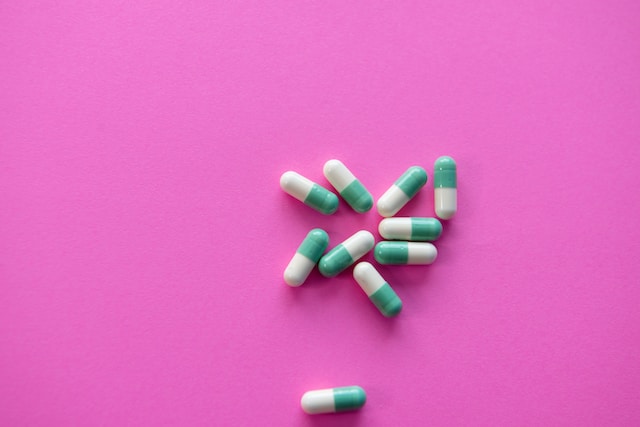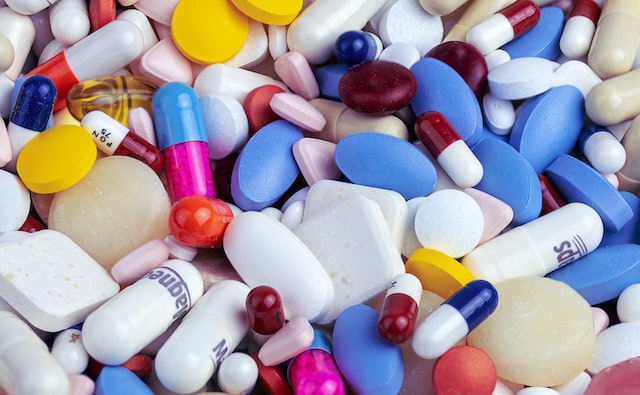Capsules are made of a soft material that dissolves easily in the stomach. They are typically smaller than tablets and are easy to swallow. Capsules are also easier to break down and absorb by the body. Tablets, on the other hand, are made of a hard material that takes longer to dissolve in the stomach. They are also larger than capsules and can be difficult to swallow. Tablets also take longer for the body to break down and absorb.
Capsules
(Photo by Christina Victoria Craft on Unsplash )

Capsules, in the context of pharmaceuticals and supplements, refer to a specific form of oral dosage. They are solid, gelatin-based containers that enclose medication, nutrients, or other substances in a convenient and easily consumable format.
Here are key points about capsules:
- Composition: Capsules are typically composed of two main parts—the body and the cap—that fit together to form a sealed container. The outer shell is commonly made of gelatin, derived from animal sources, or alternative materials such as plant-based cellulose or modified starch for vegetarian or vegan preferences.
- Types of Capsules: There are two primary types of capsules: hard capsules and soft capsules. Hard capsules are the more common variety and have a firm, rigid outer shell. Soft capsules, also known as softgels, have a flexible outer shell and are typically filled with liquid or semi-solid substances.
- Encapsulation: Capsules provide a protective shell that encloses the contents, safeguarding them from external factors like moisture, air, and light. This helps preserve the stability, potency, and shelf life of the encapsulated substance.
- Administration: Capsules are designed for oral ingestion and are swallowed whole. The outer shell is dissolved by stomach acid, allowing the contents to be released and absorbed by the body. Some capsules may have specific instructions, such as being taken with food or on an empty stomach, to optimize absorption or minimize potential side effects.
- Applications: Capsules are widely used in the pharmaceutical industry to deliver medications, including both prescription drugs and over-the-counter remedies. They are also popular in the nutritional supplement industry for delivering vitamins, minerals, herbal extracts, and other dietary ingredients.
- Advantages: Capsules offer several advantages. They are generally easier to swallow compared to tablets, particularly for individuals who have difficulty swallowing solid forms. Capsules can also mask the taste or odor of certain substances, making them more palatable. Additionally, they can allow for controlled-release formulations, where the contents are released gradually over time for sustained therapeutic effects.
- Customization: Capsules can be customized in terms of size, shape, color, and printing. This allows for product differentiation, branding, and easy identification by both healthcare professionals and consumers.
It’s important to note that some individuals may have specific dietary or religious restrictions that prevent the consumption of gelatin-based capsules. In such cases, alternative capsule formulations made from non-animal sources are available.
Capsules are oral dosage forms consisting of a gelatin-based shell that encloses medications, supplements, or other substances. They provide protection, ease of administration, and customization options, making them a popular choice in the pharmaceutical and supplement industries.
Tablets
(Photo by James Coleman on Unsplash )

Tablets, in the context of pharmaceuticals, are solid oral dosage forms that are compressed into flat, round, or oval shapes. They are a common and widely used method of delivering medications and supplements.
Here are key points about tablets:
- Composition: Tablets are composed of active pharmaceutical ingredients (APIs) or other substances, along with various excipients. The API is the medication or supplement that provides the intended therapeutic effect. Excipients are non-active ingredients that aid in the tablet’s formation, stability, and disintegration.
- Manufacturing Process: Tablets are produced through a process called compression. The API and excipients are blended together and compressed into a solid form using specialized tablet presses. The compression process creates a compact and uniform tablet with precise dosing.
- Varieties: Tablets come in various forms and can be differentiated based on their characteristics. These include immediate-release tablets that release the medication quickly after ingestion, extended-release or sustained-release tablets that release the medication gradually over a longer period, and chewable tablets that can be chewed and easily swallowed.
- Coatings: Some tablets may have coatings to enhance stability, ease of swallowing, or to control the release of the medication. Enteric coatings, for example, are designed to resist stomach acid and dissolve in the intestines to protect sensitive medications or reduce gastrointestinal irritation.
- Administration: Tablets are typically administered orally and are swallowed whole with water. They are designed to disintegrate and dissolve in the gastrointestinal tract, allowing the medication to be absorbed into the bloodstream.
- Advantages: Tablets offer several advantages. They are compact, portable, and easy to handle. Tablets can be accurately dosed, ensuring consistent delivery of medication. They also provide a stable and convenient method for long-term storage and transportation.
- Disintegration and Dissolution: Upon ingestion, tablets disintegrate into smaller particles and dissolve in the stomach or intestines, depending on the formulation. This enables the medication to be released and absorbed by the body.
- Applications: Tablets are widely used to deliver a variety of medications, including prescription drugs and over-the-counter remedies. They are also utilized for nutritional supplements, vitamins, and minerals.
It’s important to note that some individuals may have difficulty swallowing tablets, especially those with large sizes or an aversion to swallowing solid forms. In such cases, alternative dosage forms like liquids, capsules, or chewable tablets may be available.
Tablets are solid oral dosage forms composed of active ingredients and excipients, manufactured through compression. They provide a convenient and accurate way to deliver medications and supplements, allowing for controlled dosing and stable storage. Tablets come in various forms and can be tailored for immediate or extended release, depending on the desired therapeutic effect.
Pros and cons of capsules and tablets
Capsules and tablets are two common forms of oral dosage used to deliver medications and supplements. Each has its own set of advantages and disadvantages. Here are the pros and cons of capsules and tablets:
Capsules:
Pros:
- Easy Swallowing: Capsules are generally easier to swallow compared to large or bulky tablets, making them more suitable for individuals who have difficulty swallowing solid forms.
- Masking Taste and Odor: Capsules can effectively mask the taste and odor of certain medications or supplements, making them more palatable for patients.
- Versatility: Capsules can be filled with various substances, including powders, granules, pellets, and even liquids, allowing for versatile formulation options.
- Customization: Capsules can be customized in terms of size, color, and printing, allowing for branding and easy identification.
Cons:
- Limited Dosage Flexibility: Capsules may have limitations in terms of precise dosing flexibility, as the amount of medication they can contain is limited by the capsule size.
- Slower Disintegration: Some capsules may take longer to disintegrate and release their contents compared to tablets, potentially affecting the onset of therapeutic effects.
- Susceptibility to Moisture: Capsules with gelatin shells may be more susceptible to moisture, which can affect the stability and shelf life of the encapsulated substances.
- Gelatin Sensitivity: Individuals with dietary or religious restrictions may not consume capsules made from animal-derived gelatin.
Tablets:
Pros:
- Accurate Dosing: Tablets allow for precise and consistent dosing, ensuring that patients receive the intended amount of medication.
- Stability: Tablets are generally more stable and have a longer shelf life compared to capsules, especially if they are properly coated or packaged.
- Controlled Release: Tablets can be formulated as immediate-release, extended-release, or sustained-release formulations, enabling controlled and prolonged drug delivery.
- Manufacturing Efficiency: Tablet manufacturing processes are well-established and efficient, making them a cost-effective option for mass production.
Cons:
- Swallowing Difficulties: Tablets, especially those that are large or have an unpleasant taste, can be challenging to swallow, particularly for individuals with swallowing difficulties.
- Taste and Odor: Some tablets may have a bitter taste or unpleasant odor, making them less palatable for certain patients.
- Limited Formulation Options: Tablets may not be suitable for certain substances that are difficult to compress or require specialized formulations, such as liquids or volatile compounds.
- Coating Issues: Coated tablets may be susceptible to damage or breakage, which can affect the integrity and functionality of the tablet.
What is better capsule or tablet?
So, which is better – capsules or tablets? Ultimately, it comes down to personal preference. Some people prefer the convenience of capsules, while others find that tablets offer a more consistent level of medication throughout the day.
Featured Image By Myriam Zilles on Unsplash








